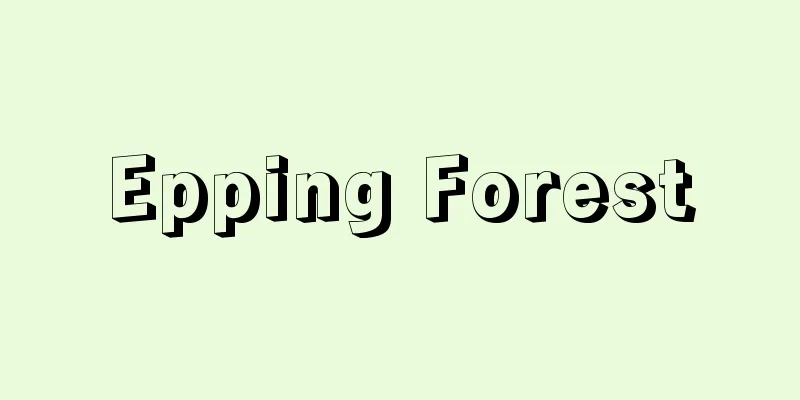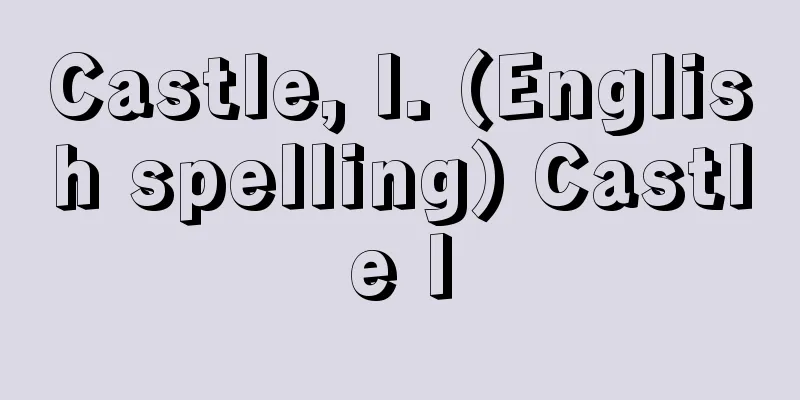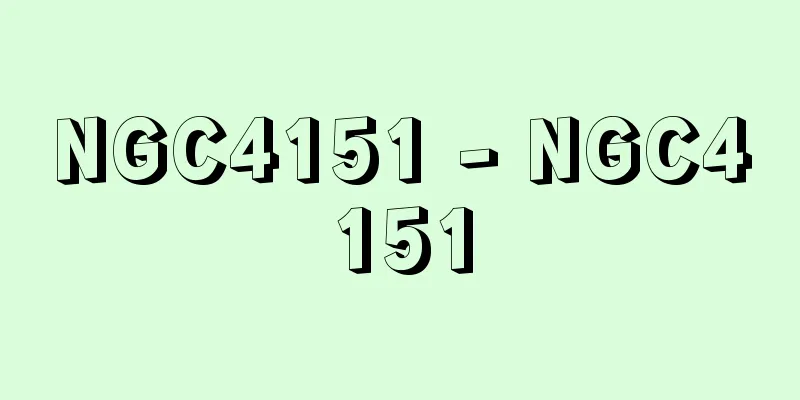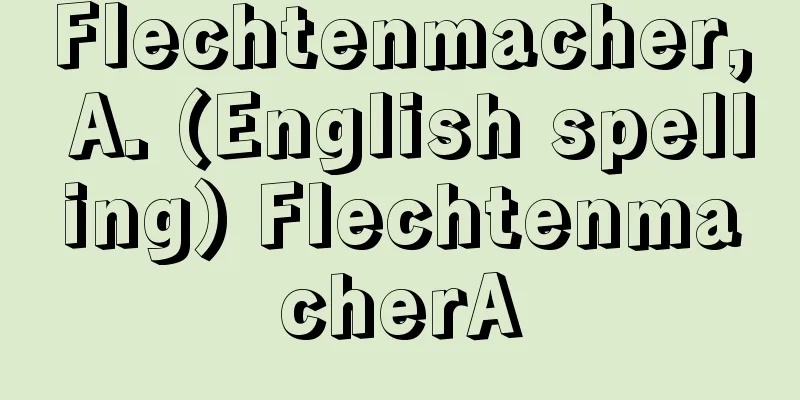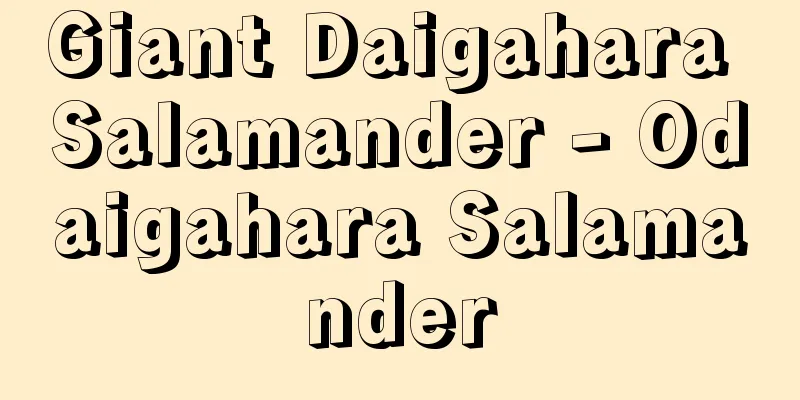Structural mechanics
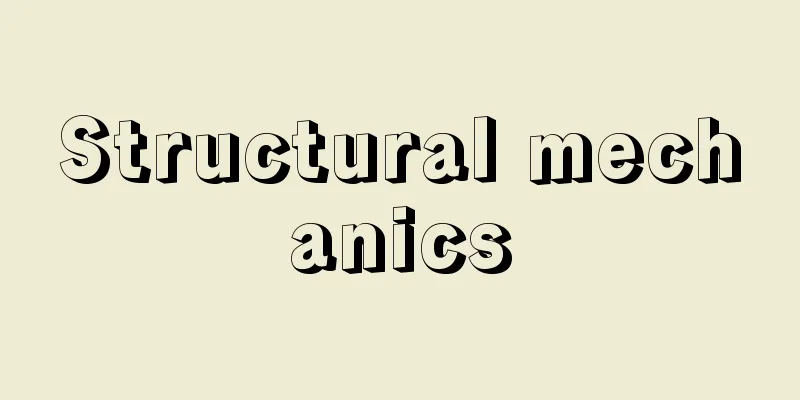
|
A structure is an object that is composed of elements of various shapes and is designed to perform a required mechanical function as a whole, such as a building, bridge, dam, aircraft, ship, or machine. The mechanical theory that predicts the behavior of a structure when it is subjected to external disturbances such as earthquakes, wind, snow, or waves, or when it is subjected to external forces according to its function, is called structural mechanics. [Tsuneyoshi Nakamura] Beam TheoryStructures are made in shapes and sizes suited to their purpose. For example, bridges are built to cross rivers and valleys and provide a flat passage for people and vehicles. The primitive form of a bridge is a single log bridge, and a rod is selected that has the length required to cross the river or valley, an almost straight axis, and a thickness that can support the weight of the object moving on it. Such a rod is called a beam, and beam theory is the basic theory of material mechanics and structural mechanics. Beam theory is based on a first approximation (called the plane-maintaining assumption) in which a beam element cut by a pair of imaginary cutting planes perpendicular to the axis of the material before deformation transitions into a sector element with a pair of planes perpendicular to the axis of the material after deformation. The bending deformation of a beam element is represented by the angle θ of the sector element. Mechanical interactions act between the imaginary cutting planes of each beam element and adjacent elements. The component perpendicular to the cut surface is called normal stress, and the component along the cut surface is called shear stress. The resultant force and moment of the interactions distributed in this way are collectively called resultant stress or section force. The governing equation for a beam is a system of simultaneous ordinary differential equations consisting of three types of equations: the relationship between the section force belonging to a point on the material axis and the element deformation (θ) (material law), the equilibrium equation between the section force and the external force acting on the element, and the relationship between the displacement of a point on the material axis and the element deformation. In this way, since all the variables in the governing equation can be attributed only to quantities belonging to a point on the material axis, a beam can theoretically be regarded as if it were a wire. [Tsuneyoshi Nakamura] Theory of frameworksA structure constructed by combining and joining many different kinds of rods is called a frame. A frame combined with flat plate elements (described below) is called a walled frame, or simply a frame. Just as the beams, which are the components of the frame, are treated as if they were wires, the frame is also treated, as a first approximation, as if wires are ideally joined at points (called nodes) where the wires have mechanical properties. The mechanics of a frame is based on the equations that describe the behavior of its element rods (called members). The behavior of a member is described by the equations that relate the end forces and moments acting on the ends of the wires, and the end displacements and rotation angles of the wires. These equations are called member stiffness equations. By applying the joint conditions at the nodes and the equations of balance between the end forces and external forces for the free bodies around the nodes to the member stiffness equations of each member of a frame, the stiffness equations for the entire frame are derived. By imposing the support conditions of the frame on this equation, simultaneous equations that describe the behavior of the frame under a given external force are derived. Analysis of the behavior of a structure is the basis of its structural design. When designing a frame, the worst or maximum level of external disturbance expected to act on the structure over a specified period after completion is evaluated, and the mechanical behavior of the frame when such external disturbances act on it is analyzed to verify that the frame has the required mechanical performance. For example, in the case of a building framework, the design load is calculated in accordance with legal provisions, the mechanical behavior of the framework under the load is analyzed, and the results are verified to see if they meet the safety regulations. [Tsuneyoshi Nakamura] Theory of plate constructionArchitectural frameworks generally include not only frameworks but also flat plate-like elements such as walls and floors. Walls and floors not only fulfill architectural planning functions but also mechanical functions. The mechanics of a single flat plate or a box-like structure made up of a combination of flat plates is also a branch of structural mechanics. Flat plates have two types of mechanical functions. Flat plates have high rigidity against external forces in the direction along the plate surface. The walls in architectural frameworks are useful for suppressing deformation of the framework and horizontal displacement of the floor due to horizontal forces. On the other hand, floors fulfill two roles: first, to support the self-weight and live load in the direction perpendicular to the plate surface, and second, to connect multiple parallel plane frames according to their high in-plane rigidity, and to integrate their resistance to external forces. shows a schematic diagram of the deformed curved surface when a rectangular flat plate is bent by the action of a load perpendicular to the plate surface. As shown in the upper diagram of , we can imagine imaginary plate elements cut out of the flat plate before deformation by two pairs of parallel planes perpendicular to the plate surface and perpendicular to each other. The shape after deformation (lower diagram in ) can be described as a superposition of bending deformation in a sector shape in two directions and torsional deformation. Furthermore, as shown in , normal stresses and shear stresses act on two pairs of opposing cross sections, resulting in resultant forces and moments. The mechanical and geometrical state of the plate element is described by the displacement, deformation and section forces belonging to a point on the central plane of the plate in the upper diagram in The governing equations for a plate consist of the section force-deformation relationship, displacement-deformation relationship and equilibrium equation of the plate element, and are generally a system of partial differential equations. The mechanics of shell structures is based on a similar concept to the mechanics of plates. In a dome-shaped shell structure, the applied load is supported by the combined effect of the arch action and the hoop action . In contrast, in a saddle -shaped shell structure with edge beams, the load is supported by the combined action of the suspension cable and the holding cable. Analysis of the behavior and collapse process of shell structures is also a field of structural mechanics. [Tsuneyoshi Nakamura] "Optimum Design of Architectural Frames" by Tsuneyoshi Nakamura (1980, Maruzen)" ▽ "Illustrated Explanation of Structural Mechanics of Architecture, Exercises I and II" edited by Tsuneyoshi Nakamura (1982, Maruzen)" ▽ "New Architectural Science Series 36: Analysis of Frame Structures" by Toshio Sato and Tsuneyoshi Nakamura (1982, Shokokusha)" ▽ "Structural Mechanics II" by Koichiro Hioki (1977, Asakura Shoten)" [Reference] | |Deformation surface of a flat plate with fixed edges subjected to a uniformly distributed lateral load ©Shogakukan "> Schematic diagram of the deformation surface (Figure A) ©Shogakukan "> Plate element before and after deformation (Figure B) ©Shogakukan "> Stress acting on the cross section of a plate element (Fig. C) Source: Shogakukan Encyclopedia Nipponica About Encyclopedia Nipponica Information | Legend |
|
建物、橋、ダム、航空機、船舶、機械など、種々の形状の要素で構成され、全体として所要の力学的機能を果たすようにつくられた物体を構造物といい、構造物が地震、風、雪、波浪などの外的攪乱(かくらん)や、機能に応じた外力の作用を受けたときに示す挙動を予測する力学理論を構造力学という。 [中村恒善] 梁の理論構造物はその目的に適合する形状と大きさでつくられる。たとえば、川や谷を横切って、人や車両に平坦(へいたん)な通行路を提供するために橋がつくられる。橋の原始的な形状は1本の丸木橋であり、橋として川や谷を横切るのに必要な長さをもち、材軸線がほぼ直線で、その上を移動する物体の重量を支持できるような太さをもつ棒材が選ばれる。このような棒材を梁(はり)といい、梁の理論は材料力学や構造力学の基礎理論である。梁の理論は、まず変形前の材軸線に垂直な1対の仮想切断面で切り出される梁の要素が、変形後には、変形後の材軸線に垂直な1対の平面をもつ扇型要素に移行するという第一近似(平面保持の仮定という)に基づいて構成される。梁要素の曲げ変形は扇形要素の角θで代表される。このような各梁要素の仮想切断面には隣接要素との間の力学的相互作用が働いている。切断面に垂直な方向の成分を垂直応力、切断面に沿う方向の成分を剪断(せんだん)応力という。このように分布する相互作用の合力および合モーメントを総称して合応力または断面力という。梁の支配式は、材軸線上の点に属する断面力と要素変形量(θ)の間の関係式(材料法則)、断面力と要素に作用する外力との間のつり合い式、および材軸線上の点の変位と要素変形量の間の関係式の3種類の式で構成される連立常微分方程式の系となる。このように、支配式のすべての変量が材軸線上の点に属する量のみに帰せられるので、梁は理論上は、あたかも線材のようにみなされたことになる。 [中村恒善] 骨組の理論多種多数の棒材を組み合わせ、接合することによって構成される構造物を骨組という。後述の平板要素と組み合わせられた骨組を有壁骨組、または単に骨組という。構成要素の梁があたかも線材として取り扱われるのに対応して、骨組もまた第一近似としては、線材と線材とが力学的性能を有する点(節点という)で理想的に接合されたものとして扱われる。 骨組の力学は、その要素棒材(部材という)の挙動を記述する式に基づいて構成される。部材の挙動は、その線材としての材端に作用する材端力、材端モーメントと、材端変位、材端回転角の間の関係式で記述される。これを部材剛性関係式という。1個の骨組の各部材の部材剛性関係式に、節点での接合条件と、節点まわりの自由体についての材端力と外力の間のつり合い式とを用いると、その骨組全体についての剛性関係式が導かれ、それにその骨組の支持条件を課すると、与えられた外力の下でのその骨組の挙動を記述する連立方程式が導かれる [中村恒善] 板構造の理論建築骨組は、一般に骨組のみならず壁や床板のような平板状の要素も含んでいる。壁や床板は、建築計画上の機能を果たすのみならず、力学的機能も果たす。1枚の平板や、その組合せでつくられる箱状構造物の力学もまた構造力学の一分野である。平板の力学的機能は2種類ある。平板はその板面に沿う方向の外力に対して高い剛性を示す。建築骨組の中の壁は、水平力による骨組の変形と床の水平変位を抑制するのに役だてられる。これに対して、床板は、第一に板面に垂直な方向の自重や積載荷重を支持し、第二にその高い面内剛性に応じて多数の並列平面骨組を連結し、それらの外力に対する抵抗作用を一体化する、という2種類の役割を果たす。には、長方形平板が板面に垂直な荷重の作用を受けて曲げられる場合の変形曲面の略図を示した。の上図のように、変形前の平板中に、板面に垂直でかつ互いに垂直な2対の平行平面で想像上切り出される板要素を考えることができる。その変形後の形(の下図)は、2方向に扇型であるような曲げ変形と、ねじれ変形との重ね合わせとして記述できる。また、のように、2対の相対する断面には垂直応力や剪断応力が作用していて、合力と合モーメントをもっている。平板要素の力学的および幾何学的状態は、上図の平板中央面上の点に属する変位量、変形量および断面力によって記述される。平板の支配式は、板要素の断面力‐変形量関係式、変位‐変形量関係式およびつり合い式で構成され、一般には偏微分方程式の系となる。 シェル構造の力学も平板の力学と類似の考え方で構成される。ドーム型シェル構造では、アーチ作用とたが作用の複合効果によって作用荷重が支持される。これに対して、縁梁をもつくら型シェル構造では、吊(つ)りケーブル作用と押さえケーブル作用の複合によって荷重が支持される。シェル構造の挙動解析、崩壊過程解析も構造力学の一分野である。 [中村恒善] 『中村恒善著『建築骨組の最適設計』(1980・丸善)』▽『中村恒善編著『建築構造力学図説・演習Ⅰ・Ⅱ』(1982・丸善)』▽『佐藤稔夫・中村恒善著『新建築学大系36 骨組構造の解析』(1982・彰国社)』▽『日置興一郎著『構造力学Ⅱ』(1977・朝倉書店)』 [参照項目] | |等分布横荷重の作用を受ける周辺固定平板の変形曲面(たわみ曲面)©Shogakukan"> 変形曲面の略図〔図A〕 ©Shogakukan"> 変形前後の板要素〔図B〕 ©Shogakukan"> 板要素の断面に作用する応力〔図C〕 出典 小学館 日本大百科全書(ニッポニカ)日本大百科全書(ニッポニカ)について 情報 | 凡例 |
Recommend
Carbon tissue
…Type and letters are copied from proof prints ta...
Performance symbols - Vortragsbezeichnungen (German)
The notation method using five lines, which was a...
Gold - Kin
Au. Element with atomic number 79. Group 11 trans...
Lullus, Raimundus
Born: 1235, Catalonia [Died] 1316.1? Bougie Spanis...
Asazuke - Asazuke
〘 noun 〙 Pickling for a short period of time. Also...
Kurume Kasuri
Kurume City, Fukuoka Prefecture, is the center of...
Schweizerische Eidgenossenschaft (English notation) Schweizerische Eidgenossenschaft
...Official name: Swiss Confederation Schweizeris...
Election - Election
〘 noun 〙 A system in which the emperor himself set...
Pinter - Pintar (English spelling) Harold Pinter
British playwright. Born in the working-class of ...
cake filter
…Filters that perform filtration operations are b...
American Filter
...The most typical vacuum filter is a continuous...
Ministry of Finance Deposit Department - Okura Shoyokinbu
→Fund Management Department Source : Heibonsha Enc...
"The Battle of Osaka in Summer" - The Battle of Osaka in Summer
According to the Honmaru map by the master carpen...
Large sword - Oodachi
〘Noun〙 (formerly called "Ootachi")① A la...
Savannah
A grassland area distributed in the intermediate z...

